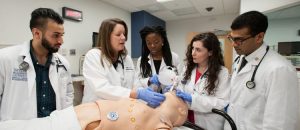
Becoming a doctor in the United States is a journey that requires dedication, years of education, practical experience, and a commitment to lifelong learning. It’s a rewarding and challenging path that demands a deep passion for medicine and a genuine desire to help others. From the initial steps of undergraduate education to specialized training, the process of becoming a doctor is rigorous but fulfilling.
1. Undergraduate Education

The journey to becoming a doctor typically begins with a solid foundation in undergraduate studies. While there isn’t a specific major required for medical school, aspiring doctors often pursue degrees in biology, chemistry, biochemistry, or other related fields. Maintaining a high GPA and excelling in science courses is crucial for admission to medical school.
2. Medical College Admission Test (MCAT)
The MCAT is a standardized exam that assesses an individual’s knowledge of scientific concepts, critical thinking, and problem-solving skills. A strong MCAT score is essential for acceptance into medical school. Preparation for the MCAT often involves months of studying and practicing for exams to achieve the best possible results.
3. Medical School

Upon successful completion of the MCAT and undergraduate studies, the next step is attending medical school. Medical school typically lasts four years and involves a combination of classroom learning and clinical experience. The first two years focus on foundational coursework covering subjects like anatomy, physiology, pharmacology, and pathology. The latter two years involve clinical rotations where students work under the supervision of experienced physicians, gaining hands-on experience in various specialties.
4. United States Medical Licensing Examination (USMLE)
During medical school and afterward, aspiring doctors must pass a series of licensing exams. The USMLE is a three-step examination that assesses a physician’s ability to apply their medical knowledge and skills to patient care. Step 1 is typically taken after the second year of medical school, Step 2 is taken during the final year, and Step 3 is usually taken during residency.
5. Residency Training
After graduating from medical school, aspiring doctors enter residency programs, where they receive specialized training in their chosen field of medicine. Residency programs can last anywhere from three to seven years, depending on the specialty. During this time, residents work in hospitals or clinical settings under the supervision of experienced physicians, gaining hands-on experience in patient care.
6. Specialty Fellowship (Optional)
Some doctors choose to pursue additional training through fellowship programs to further specialize in a particular area of medicine. Fellowships typically last one to three years and provide advanced training in subspecialties such as cardiology, oncology, or gastroenterology.
7. Board Certification
Upon completion of residency and/or fellowship training, doctors may seek board certification in their specialty. Board certification involves passing rigorous exams administered by specialized medical boards. While it’s not mandatory to practice medicine, board certification demonstrates a high level of expertise and commitment to a specialty.
8. Continuing Medical Education (CME)
Throughout their careers, doctors are required to engage in continuing medical education to stay current with advancements in medicine, technology, and patient care. This involves attending conferences, seminars, and workshops, as well as completing CME credits to maintain licensure and board certification.
Conclusion
Becoming a doctor in the United States is a demanding yet immensely rewarding journey that requires dedication, perseverance, and a genuine passion for medicine. The path involves rigorous education, practical experience, and ongoing commitment to lifelong learning. From undergraduate studies to medical school, residency, and beyond, the process of becoming a doctor is a testament to the dedication and compassion required to provide quality healthcare to patients.



